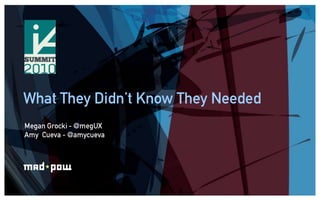
What They Didnt Know They Needed Ia Summit2010
- 1. What They Didn’t Know They Needed Megan Grocki - @megUX Amy Cueva - @amycueva
- 2. Who are we? We’ll share some stuff…but we are just scratching the surface!
- 4. Getting the right information from research
- 7. User-Centered Design We love users.
- 10. Triading
- 11. Storytelling
- 12. Game Play
- 15. Get beyond surface to their core values and uncover meaning
- 16. Experiences designed based on meaning have more traction than those based on attributes
- 18. Triading Discover dimensions that are relevant to audience
- 20. Give human characteristics to an interface
- 21. Their perspective on how they interact with it
- 24. Ease stress on participants, making them less reserved
- 25. Allows researchers to observe people in competition
- 29. Halo Affect
- 30. Why not just ask them which design they like better?
- 31. Assess emotional impact and how it aligns with brand
- 34. Ethnography
- 35. Bodystorming
- 38. Laddering
- 39. Triading
- 40. Storyteling
- 41. Game Play
- 43. So you’ve gotten to the core of what makes people tick, their emotional triggers, and their cognitive expectations. The team gets it.Now what??
- 44. Generate some fracking amazing ideas.
- 46. What is your organization’s risk tolerance threshold?
- 47. Who will be involved in generating ideas, communicating them, and executing on them?
- 49. Brain Writing
- 50. Brain Drawing
- 51. User-Centric Narrative & Storytelling
- 52. Slot Machine of Goodness
- 53. Brainstorming SoloChauncey Wilson is the master.
- 54. A C B A B C D E D E Topic H G F F G H Lotus Blossom Technique Topic
- 55. Brain Writing Procedure 1 Present a group with a request for ideas Ask people to write down ideas Take those ideas and pass them to another person who reads the ideas and adds several more Iterate several times (generally taking no more than 5-15 minutes) Procedure 2 Hand pages out to each person Ask the person to write 3 ideas on a page and put it in a pile and take one from the pile (or a clean sheet), read the items and add a few more Repeat several times and collect all the pages Twist: This method could be tried via email
- 57. Requires people to write and draw quickly and show their results to others on the team
- 58. Twist: This could be tried in “asynchronous” fashion in a group areaBrain Drawing for the concept “Filter Object”
- 59. User-Centered Narrative & Storytelling
- 61. Lists in Columns
- 62. Select one from each column
- 63. Ideas in the overlapTopics Maslow’s Hierarchy of Needs Channels, Attributes, or Methods
- 65. Go crazy on a whiteboard. SKETCH. Just. Go. Crazy.
- 66. Take a shower. The water increases circulation to your brain.
- 67. Caffeinate and eat chocolate.
- 68. Go for a drive, rock out. This can facilitate your “brain marination”.
- 69. Take a break, or switch tasks.
- 70. Go to sleep. But before you do briefly contemplate the problem.
- 72. Divide and conquer: Distribute concepting responsibilities
- 73. Validate: A design is just a hypothesis until you see it being used.
- 74. Prioritize: How will you prioritize the ideas?
- 76. De-mystify it. Don’t freak them out with big words or big budgets to start (unless they get it of course).
- 77. Involve the business in the process. Have them brainstorm. Have them design. Have them witness research and testing.
- 78. Work with them, how can they make sure this idea will not lose the business money or get them fired?
- 80. Contact Us
